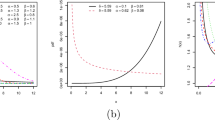Abstract
Stochastic models for correlated count data have been attracting a lot of interest in the recent years, due to their many possible applications: for example, in quality control, marketing, insurance, health sciences, and so on. In this paper, we revise a bivariate geometric model, introduced by Roy (J Multivar Anal 46:362–373, 1993), which is very appealing, since it generalizes the univariate concept of constant failure rate—which characterizes the geometric distribution within the class of all discrete random variables—in two dimensions, by introducing the concept of “locally constant” bivariate failure rates. We mainly focus on four aspects of this model that have not been investigated so far: (1) pseudo-random simulation, (2) attainable Pearson’s correlations, (3) stress–strength reliability parameter, and (4) parameter estimation. A Monte Carlo simulation study is carried out in order to assess the performance of the different estimators proposed and application to real data, along with a comparison with alternative bivariate discrete models, is provided as well.



Similar content being viewed by others
References
Barnett, V. (1980). Some bivariate uniform distributions. Communications in Statistics - Theory and Methods, 9(4), 453–461.
Basu, A. P., & Dhar, S. K. (1995). Bivariate geometric distribution. Journal of Applied Statistical Science, 2, 33–44.
Bracquemond, C, Cretois, E., & Gaudoin, O. (2002). A comparative study of goodness-of-fit tests for the geometric distribution and application to discrete time reliability. Laboratoire Jean Kuntzmann, Applied Mathematics and Computer Science, Technical Report.
Dhar, S. K. (1998). Data analysis with discrete analog of Freund’s model. Journal of Applied Statistical Science, 7, 169–183.
Fiondella, L., & Zeephongsekul, P. (2016). Trivariate Bernoulli distribution with application to software fault tolerance. Annals of Operations Research, 244(1), 241–255.
Freund, J. E. (1961). A bivariate extension of the exponential distribution. Journal of the American Statistical Association, 56(296), 971–977.
Galambos, J., & Kotz, S. (1978). Characterizations of probability distributions. Berlin: Springer.
Gumbel, E. J. (1960). Bivariate exponential distributions. Journal of the American Statistical Association, 55(292), 698–707.
Hawkes, A. G. (1972). A bivariate exponential distribution with applications to reliability. Journal of the Royal Statistical Society Series B, 34(1), 129–131.
Huber, M., & Maric, N. (2014). Minimum correlation for any bivariate geometric distribution. Alea, 11(1), 459–470.
Jovanović, M. (2017). Estimation of \(P\{ X < Y\} \) for geometric-exponential model based on complete and censored samples. Communications in Statistics - Simulation and Computation, 46(4), 3050–3066.
Khan, M. S. A., Khalique, A., & Abouammoh, A. M. (1989). On estimating parameters in a discrete Weibull distribution. IEEE Transactions on Reliability, 38(3), 348–350.
Krishna, H., & Pundir, P. S. (2009). A bivariate geometric distribution with applications to reliability. Communications in Statistics - Theory and Methods, 38(7), 1079–1093.
Maiti, S. S. (1995). Estimation of \(P (X \le Y)\) in the geometric case. Journal of Indian Statistical Association, 33, 87–91.
Mari, D. D., & Kotz, S. (2001). Correlation and dependence. Singapore: World Scientific.
Marshall, A. W., & Olkin, I. (1967). A multivariate exponential distribution. Journal of the American Statistical Association, 62(317), 30–44.
Mitchell, C. R., & Paulson, A. S. (1981). A new bivariate negative binomial distribution. Naval Research Logistic Quarterly, 28(3), 359–374.
Nelsen, R. B. (1999). An introduction to Copulas. New York: Springer.
Paulson, A. S., & Uppuluri, V. R. R. (1972). A characterization of the geometric distribution and a bivariate geometric distribution. Sankhyā Series A, 34(3), 297–300.
Phatak, A. G., & Sreehari, M. (1981). Some characterizations of a bivariate geometric distribution. Journal of Indian Statistical Association, 19, 141–146.
R Core Team. (2018). R: A language and environment for statistical computing, R Foundation for Statistical Computing, Vienna, Austria. URL https://www.R-project.org/.
Roy, D. (1993). Reliability measures in the discrete bivariate set-up and related characterization results for a bivariate geometric distribution. Journal of Multivariate Analysis, 46(2), 362–373.
Sklar, A. (1959). Fonctions de répartition à n dimensions et leurs marges. Publications de l’Institut de Statistique de l’Université de Paris, 8, 229–231.
Sun, K., & Basu, A. P. (1995). A characterization of a bivariate geometric distribution. Statistics and Probability Letters, 23(4), 307–311.
Xekalaki, E. (1983). Hazard functions and life distributions in discrete time. Communications in Statistics - Theory and Methods, 12(21), 2503–2509.
Acknowledgements
I would like to thank the Editor-in-Chief, the Guest Editor, and the anonymous referees for their valuable comments on an earlier draft of this article. I acknowledge the financial support to the present research by the University of Milan (Piano di Sostegno alla Ricerca 2015/2017-Linea 2A).
Author information
Authors and Affiliations
Corresponding author
Additional information
Publisher's Note
Springer Nature remains neutral with regard to jurisdictional claims in published maps and institutional affiliations.
Rights and permissions
About this article
Cite this article
Barbiero, A. Properties and estimation of a bivariate geometric model with locally constant failure rates. Ann Oper Res 312, 3–22 (2022). https://doi.org/10.1007/s10479-019-03165-7
Published:
Issue Date:
DOI: https://doi.org/10.1007/s10479-019-03165-7




